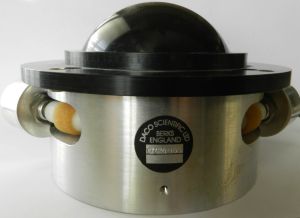Roller Ball Module



| Catalogue Number | C0921 |
| Sub-categories | |
| Location | Triple Shelf Unit, Mid (control panels) [Main Store] |
| Object Type | Control/Data Entry |
| Division | Unknown |
| Platform | |
| Manufacturer | |
| Part No | DT630-105 |
| Serial No | 38850 |
| Dimensions | Width (mm):130 Height (mm):75 Depth (mm):132 Weight (g):882 |
| Inscription(s) | Daco Scientific Ltd Berks. England DT630-105 38850 ──────────────── [the two shaft encoders] Daco Scientific Ltd Berks. England DE200-8 38596 & 38597 ──────────────── [the circuit board] Daco D/TB/00221/3 Iss B ──────────────── [paper label] GAv (R) MASD 154586 |
| Notes | This unit is like the roller-ball assembly inside the related items. |
This type of Roller Ball Unit was used as a ‘Mouse’ to control a cursor on the display screen of the AQS902 and AQS920 Sonar systems. These Sonar systems were fitted to the Royal Navy Sea King MkV and VI, The Indian Navy Sea King Mk42B, the Italian Navy Atlantic Mk1, the Swedish Navy and the Grumman S2-T.
Planning by the MOD for a comprehensive avionics upgrade for the Nimrod Mark I MR ASW had begun in 1975. The Royal Air Force realised that, within ten years of the Nimrod entering service, advances in Soviet submarine technology would outstrip the MR.l’s systems. The new equipment suite included a Thorn EMI Searchwater radar in place of the aging ASV-21D unit, a new GEC Central Tactical System and the AQS-901 acoustics system compatible with the latest ‘Barra’, Cambs and Dicass sonobuoys.
Thirty-five MR.l were upgraded to the new Maritime Reconnaissance 2 standard, with the first aircraft being redelivered to the RAF on 23 August 1979.
AQS 901 was also fitted to Royal Australian Air Force Lockheed P-3C Orions under a UK/ Australian programme which included the Australian-designed Barra passive sonobuoy.
The function of the Nimrod ASW system, known as AQS901, was the processing and display of the information received from Sonobuoys. There were two major subcontractors; Computing Devices of Canada who developed the Fast Fourier Transform (FFT) Analyser and Rank Pullen who developed and provided four chart recorders.
The AQS-901 system ultimately consisted of 20 units of electronic equipment which covered radio receivers, buoy signal processors, computer units, controls, CRT and Hard Copy displays. Both the Nimrod and Orion aircraft carried two complete independent sets of these plus another shared CRT display, control unit and a radio transmitter - 43 items in total. Each aircraft had an acoustics station seating two Sonics Operators and a Tactical Coordinator. Processed information was presented on cathode-ray tube displays and hard copy recorders. Flexibility to handle existing and projected active and passive buoys was built in. The system was based on the Marconi Avionics 920 ATC digital computer with a memory capacity of 256K words. The AQS-901 main computer was a version of the Marconi-Elliott 920 ATC, with a nominal 64,000-word store which is expandable up to 256,000 words. Bulk memory units provide extra capacity. The system converts sonobuoy data for presentation on electronic displays or multi-channel paper recorders.
An important feature of AQS 901 was the Computing Devices Fast Fourier Transform (FFT) analyser. This allowed the constituent frequencies of a received signal to be separated and averaged over a short period. Regular noise was amplified relative to random noise, even though the latter may be much stronger at a given instant. The Canadian FFT analyser is able to perform a 2,048 complex transform in 11.25 milliseconds.
The Nimrod AQS901 displayed the processed sonobuoy signal outputs to two operators seated behind two large keyboards with five very high definition CRTs and two multi-function pen recorders. A further component, also supplied by Marconi Avionics, was the very high capacity digital recording system which enabled, amongst other modes, target signature capture and playback either in the air, after landing or when airborne on the next mission.
The Company later developed a cut-down version of AQS901 for the Westland Sea King helicopter retrofit programme and, later still, developed an enhanced system for the Agusta-Westland EH 101 helicopter (now known as the Merlin).’
The scale of the Nimrod acoustic signal processing system was such that Airborne Computing Division had to concentrate on the Maritime aircraft market. The size of this contract merited the formation, in 1973, of a dedicated Maritime Aircraft Systems Division (MASD) which was prime contractor, with Computing Devices Company of Canada as major subcontractor. This led on to other smaller systems, known as the AQS 902 series, for helicopters and other lighter aircraft which were supplied to a number of different navies, including the Swedish. Starting in 1983, the AQS 902 system was developed into the AQS 903, which went into production in 1985. In 1983, Maritime Aircraft Systems Division (MASD) was the first division of GEC/Marconi Avionics to be awarded the Queen’s Award for Technological Innovation for its successful acoustic processor developments over the past 10 years.
FLIGHT International, 5 April 1980 and with thanks from Simon Lavington’s Book ‘Moving Targets’


